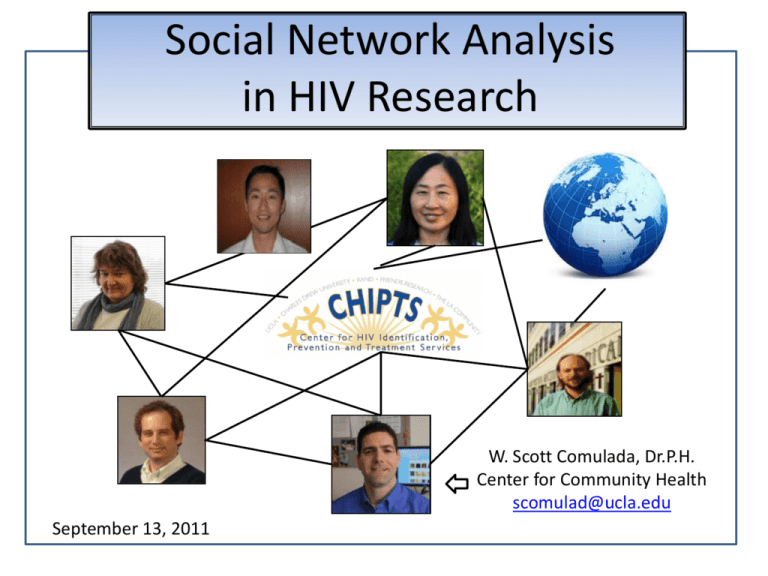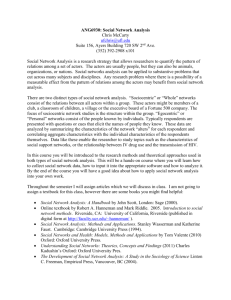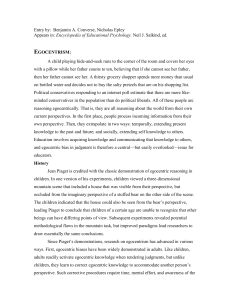Social Network Analysis in HIV Research
advertisement

Social Network Analysis in HIV Research W. Scott Comulada, Dr.P.H. Center for Community Health scomulad@ucla.edu September 13, 2011 Background What do we mean by ‘social network analysis’? Focus on … relationships between individuals rather than characteristics of individual Background Original studies collected sociometric data A few large networks in closed environments e.g. schools, offices, etc. Background Ego Study participant Alter Network member Subsequent studies also collected egocentric data Many smaller (often disconnected) networks Applicable to HIV research on marginalized populations Why is the social network framework important? Strikes balance between Ecological fallacy – inferences on individuals from aggregate-level data And Reductionist fallacy – inferences at aggregate level from individual-level data Why is the social network framework important? Example in condom use practices with sex partners Ecological fallacy – infer practices from aggregate partner data Reductionist fallacy – infer practices only from partner-level data Why is the social network framework important? Successful HIV interventions need to address structural factors (Coates et al., 2008) * Includes the social environment * Solution: Social network-based interventions a.k.a. Positive-peer deviant models, popular opinion leader models HIV prevention examples Injection drug users (Heckathorn, 1999) South African infants (Rotheram-Borus et al., in press) Egocentric study designs Basic egocentric studies (assessment only on egos) • Same recruitment strategies as non-S.N. studies, e.g. convenience samples Hybrid egocentric-sociometric studies (assessment on egos and some alters) • Snowball sampling (Goodman, 1961) – friends recruit friends • Respondent driven sampling (Heckathorn, 1997, 2002) weights snowball sample to account for non-random recruitment Egocentric designs in HIV research General challenges • Often conducted with marginalized, hard-toreach populations – E.g. Drug users • We observe incomplete networks • Hard to generalize results Egocentric designs in HIV research Longitudinal challenges in collecting repeated alter observations • Networks not stable over time, e.g. unstable relationships with drug using network members • Difficulty in linking alter data that is repeated – IRB issues in collecting enough information to indentify alters Egocentric designs in HIV research Two examples: Network-based interventions to reduce HIV-transmission behaviors conducted in drug-using neighborhoods in Baltimore Maryland • SHIELD study (recruitment, 97-99; Latkin et al., 2003a) – Linkage through alter first names and demographics • STEP study (recruitment, 04-06; Tobin et al., 2010) – Linkage by explicitly asking egos which alters were discussed during previous assessment The promise of social media Wait, I didn’t promise anything! Oh, but I did and it’s already paying off. That hot venture capitalist is really checking me out. The promise of social media Assessment of “off” and online networks potentially capture different networks and measure different constructs – Alters reported on paper and Facebook (Vernon, 2011) – Sociometric networks reported on paper and through e-mail (Quintane & Kleinbaum, 2011) The promise of social media – Fits in with what has been long known: Observed and self-reported behavioral interactions do not relate very well (Bernard & Killworth, 1977) – Pen paper: perceptions • Sometimes more important for behavior change • Perceived versus actual alter behavior more strongly related to ego behaviors (Valente, 2005) – Electronic: actual contacts • More important for disease spread, diffusion of ideas The promise of social media Supplement traditional pen-and-paper name generating questions with online media – e.g. SIM card reader to allow for alter identification from phone contact list (Schneider et al., 2011) The promise of social media • Allows for sociometric approach necessary to understand risk network structure e.g. 1996 Swedish survey of sexual behavior (n = 2810) – Important finding: Distribution for number of partners not normal / exponential, closer to scale-free distribution – Explanation: Increased skill in acquiring new partners as number of previous partners grows, “rich get richer” – Implications for disease propogation – Survey was pen-and-paper! Think of possibilities that social media brings. Reference: Liljeros et al., 2001 Social media tools • Recruitment – Social networking websites, e.g. Facebook • Data collection – Computer tablets, e.g. Apple iPad: “SNA Observer”, S.N. application (Hansberger, 2011) – Mobile phones The promise of social media Potential barrier: IRB Early adopting CHIPTS researchers are paving the way… in recruitment (Facebook; PI: Sean Young) and in assessment (mobile phones; Dallas Swendeman; Nithya Ramanathan) Online recruitment strategies (See Gjoka et al. for overview) Graph traversal techniques • Breadth-First Search – Visit all nodes within given distance of starting node 1 e.g. within 2 degrees 2 1 2 Problem: Favors larger networks 2 Online recruitment strategies Random walks (“Biased” walks since nodes are not resampled) • Next node is chosen with equal probability from among adjacent nodes that have not been sampled Problem: Favors larger networks Assumption: Large population, bias is minimal (Tomas, 2011) Online recruitment strategies Metropolis-Hastings Random Walk • Corrects for bias from favoring larger networks • Example selection procedure (k = # of connections): Step 1: Select candidate node (B) with equal probability from nodes adjacent to A Step 2: Generate random uniform number U~ Unif[0,1] Step 3: If U < kA / kB, jump to B; Otherwise, stay at A Step 4: Repeat Common egocentric variable types • Characteristics of egos and alters • Ego-alter and alter-alter ties • Network structure, commonly – Network size = # of alters – Density = # of alter ties / # of possible alter ties • If n alters, are n (n-1) / 2 possible alter ties e.g., Density = 1 / 3 Three network structure variables related to risk taking in “risky” networks (Trotter II et al., 1995) *e.g., Sociometric drug using networks * • ↑ Density, ↑ risk Transitive • ↑ Transitivity, ↑ risk Broken (Proportion of transitive triplets) • ↑ Centrality (Bonacich eigenvector), ↑ risk More on centrality • Basic centrality measure: Degree centrality # of connections or “degrees” each network member has with other members Problem: May not capture “influence” e.g., A and B have same degree centrality A B A may be more central but less influencial than B (members connected to B are more isolated) More on centrality Alternative measure to capture centrality and influence: Bonacich eigenvector centrality Calculation incorporates weights for connectedness of neighbors Bottom line: Centrality / influence are not always easy to measure or interpret For example…… Is Bieber more influential than… Obama, the Dalai Lama, or WHAT??!! your mamma? At least online, according to Klout (for Obama and the Dalai Lama). Having a lot of connections, i.e. twitter followers, only gets you so far in the rating… Social network analysis • Historically, more focused on sociometric data • Cross-sectional, Exponential random graph models (e.g., Wasserman et al., 1996) • Longitudinal, Stochastic actor-based models (e.g., Snijders, 1996), “Rsiena” downloadable from http://cran.r-project.org/ for R Common egocentric analyses *Same tools used for non-S.N. analysis * • Basic statistical tests, e.g. chi-square, t-test • Relationship between # of drug users / sex partners / kin in network and trading sex (Latkin et al., 2003b) • Regression – Impact of network intervention (Latkin et al., 2003a) – Relationship between ego-alter ties and other characteristics (dyadic analyses) • e.g., Relationship between syringe sharing and order of alter nomination (Valente and Vlahov, 2001) Dyadic analyses • Issue: Correlations between ego-alter ties within networks • Cross-sectional: Hierarchical models (Valente, 2010, chapter 4) – Include random effect for ties within each egocentric network – Analyze through random effect regression in favorite software package, e.g. binary ties through logistic regression in PROC GLIMMIX in SAS Longitudinal dyadic analyses Very recent! (e.g., Lubbers et al., 2010) Bivariate longitudinal models for egocentric networks Example from Bohnert et al., 2009 • Bivariate outcomes: Ego drug use and composite measure for network-level use • Tested competing theories: 1. Drug users choose drug using networks (social selection; homophily; Lazarsfeld & Merton, 1954) 2. Drug users influence drug use (social influence) • Structural equation models in MPLUS Bivariate longitudinal models for egocentric networks Can also examine bivariate outcomes at alter level • Same data, ego-alter ties on trust and drug use with alters Problem: Additional random effects Solution: Bayesian approach in WinBUGS General issues with hierarchical egocentric analyses Sparse nesting * Most alters reported on at one time point * 1 2 3 Wave 1 1 4 5 Wave 2 6 7 8 5 Wave 3 General issues with hierarchical egocentric analyses Sparse nesting *Network members shared across networks* 1 2 3 Network 1 1 4 5 Network 2 General issues with hierarchical egocentric analyses Network-level random effects give more weight to larger networks • Assumption: measurements are representative of population, regardless of network size • Possibly reduces bias if reporting on smaller networks more likely to be incomplete • Conversely, what if reporting on larger networks more biased? Egos less likely to know or become fatigued References Bernard, H.R., Killworth, P.D., 1977. Informant accuracy in social network data ii. Human Communication Research, 4, 3-18. Bohnert, A.S.B., Bradshaw, C.P., Latkin, C.A., 2009. A social network perspective on heroin and cocaine use among adults: Evidence of bidirectional influences. Addiction 104, 1210-1218. Coates, T.J., Richter, L., Caceres, C., 2008. Behavioral strategies to reduce HIV transmission: how to make them work better. Lancet, 372, 669 – 684. Goodman, L.A., 1961. Snowball sampling. Annals of Mathematical Statistics, 32, 148–170. Gjoka, M., Kurant, M., Butts, C.T., Markopoulou, A. Walking in Facebook: A Case Study of Unbiased Sampling of OSNs. Downloaded August 24, 2011: http://mkurant.com/publications/papers/Walking_in_Facebook_Infocom_10.pdf. Hansberger, J.T., 2011. The SNA Observer: A tool for collecting real-time longitudinal sna data. Poster session, INSNA conference, Florida, February 2011. Heckathorn, D.D., 1997. Respondent driven sampling: A new approach to the study of hidden populations. Social Problems 44, 174-199. Heckathorn, D.D., Broadhead, R.S., & Anthony, D.L., 1999. AIDS and social networks: HIV prevention through network mobilization. Sociological Focus 32, 159-179. Heckathorn, D.D., 2002. Respondent-Driven Sampling II: Deriving valid population estimates from chain-referral samples of hidden populations. Social Problems 49, 1134. Latkin, C.A., Sherman, S., Knowlton, A., 2003a. HIV prevention among drug users: outcome of a network-oriented peer outreach intervention. Health Psychology 22, 332339. Latkin, C.A., Hua, W., Forman, V.L., 2003b. The relationship between social network characteristics and exchanging sex for drugs or money among drug users in Baltimore, MD, USA. International Journal of STD & AIDS 14, 770-775. Lazarsfeld, P., Merton, R.K., 1954. Friendship as a Social Process: A Substantive and Methodological Analysis. In: Berger, M., Abel, T., Page, C.H., editors. Freedom and Control in Modern Society. Van Nostrand: New York, pp. 18–66. Liljeros, F., Edling, C.R., Amaral, L.A.N., Stanley, H.E., Aberg, Y., 2001. The web of human sexual contacts. Nature, 411, 907-908. References (continued) Lubbers, M.J., Molina, J.L., Lerner, J., Brandes, U., Avila, J., McCarty, C., 2010. Longitudinal analysis of personal networks. The case of Argentinean migrants in Spain. Social Networks 32, 91-104. Quintane, E., Kleinbaum, A.M., 2011. Matter over mind? E-mail data and the measurement of social networks. Connections, 31, 20-43. Rotheram-Borus, M.J., LeRoux, I.M., Tomlinson, M., Mbewub, N., Comulada, W.S., Le Roux, K., Stewart, J., O’Connor, M.J., Hartley, M., Desmond, K., Greco, E., Worthman, C.M., Idemundia, F. Philani Plus (+): a randomized controlled trial of mentor mother home visiting program to improve infants’ outcomes. Prevention Science, in press. Schneider, J.A., Kapur, A., Oruganti, G., Schumm, P., Laumann, E.O., 2011. A novel hybrid egocentric-archival network characterization approach using cell phones to identify bridging actors in a high risk HIV/sti network in India: The Secunderabadi Men’s Study (sms). Oral presentation, INSNA conference, Florida, February 2011. Snijders, T.A.B., 1996. Stochastic actor-oriented dynamic network analysis. Journal of Mathematical Sociology 21, 149–172. Tobin, K.E., Kuramoto, S.J., Davey-Rothwell, M.A., Latkin, C.A., 2010. The STEP into Action study: a peer-based, personal risk network-focused HIV prevention intervention with injection drug users in Baltimore, Maryland. Addiction 106, 366-375. Tomas, A. Model[l]ing the effect of differential recruitment on the bias of estimators for respondent-driven sampling. Dowloaded August 31, 2011. http://www.stats.ox.ac.uk/~tomas/html_links/DiffRecruitBandB.pdf. Trotter II, R.T., Baldwin, J.A., Bowen, A.M., 1995. Network structurre and proxy network measures of HIV, drug and incarceration risks for active drug users. Connections 18, 88-103. Valente, T.W., 2005. Network models and methods for studying the diffusion of innovations. In: Carrington, P.J., Scott, J., Wasserman, S. (Eds.), Models and Methods in Social Network Analysis. Cambridge University Press, New York, NY., p. 106. Valente, T.W., 2010. Social Networks and Health: Models, Methods, and Applications. New York: Oxford University Press. Valente, T.W., Vlahov, D., 2001. Selective risk taking among needle exchange participants in Baltimore: Implications for supplemental interventions. American Journal of Public Health 91, 406-411. Vernon, M.C., Danon, L., House, T.A., Read, J.M., Keeling, M.J., 2011. Online and offline ego-centered network data collection. Oral presentation, INSNA conference, Florida, February 2011. Wasserman, S., Pattison, P., 1996. Logit models and logistic regressions for social networks: I. an introduction to Markov graphs and p*. Psychometrica 61, 401-425.





